Photos showing various external features of Aurora, as well as towing preparation.

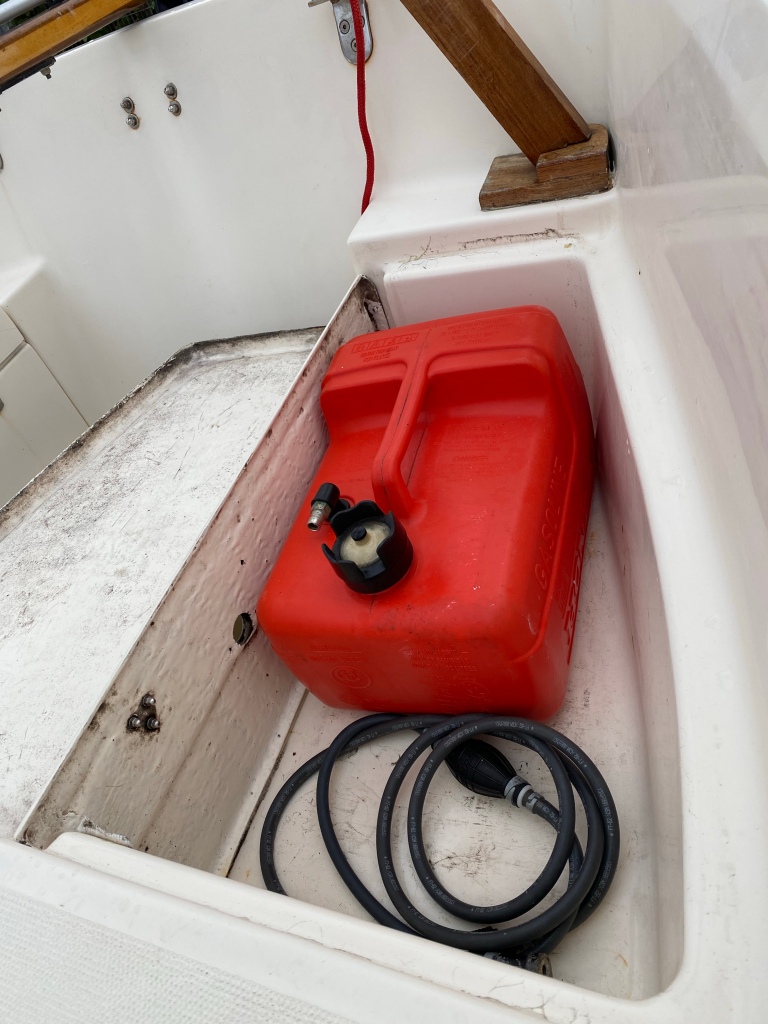

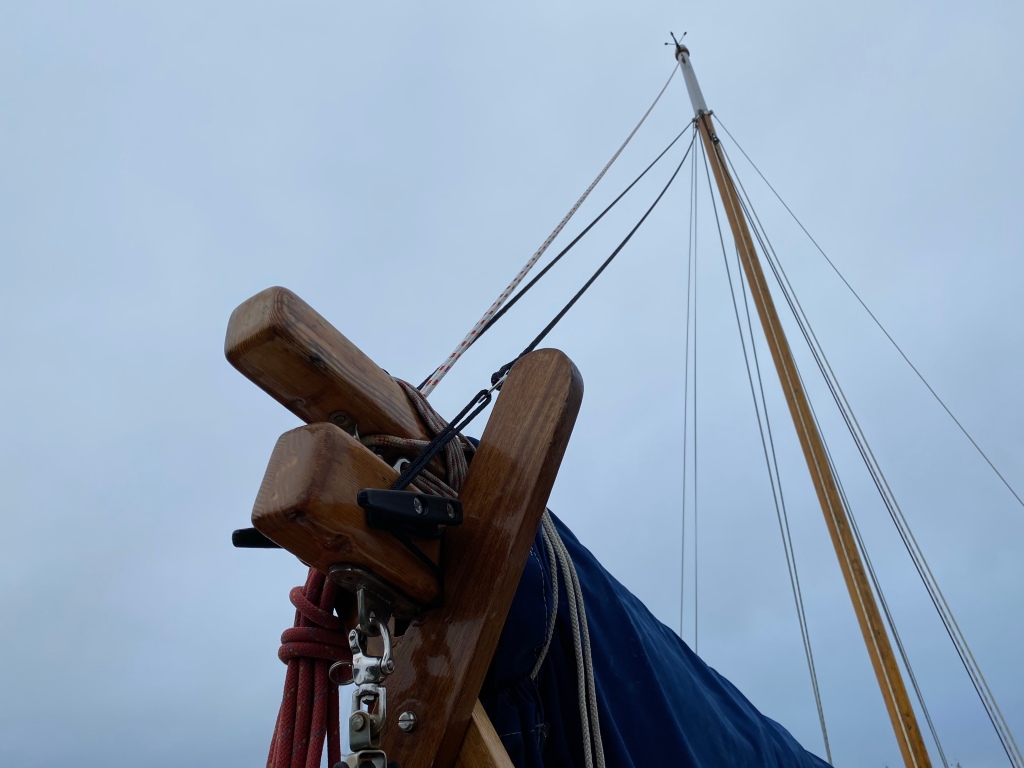
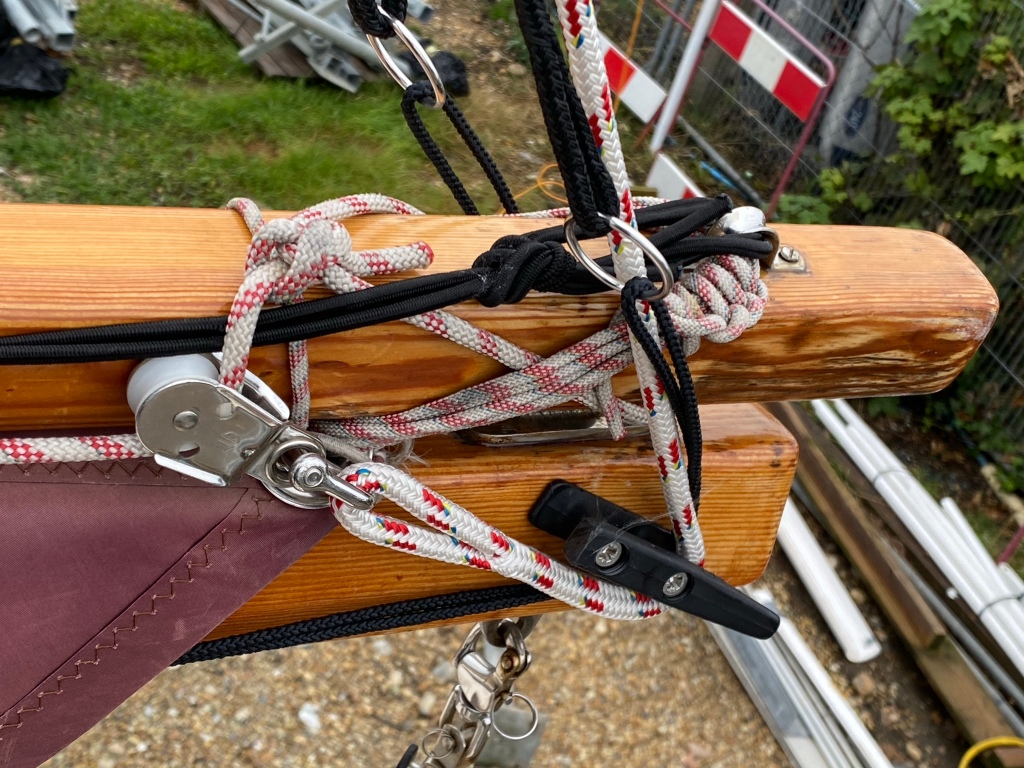
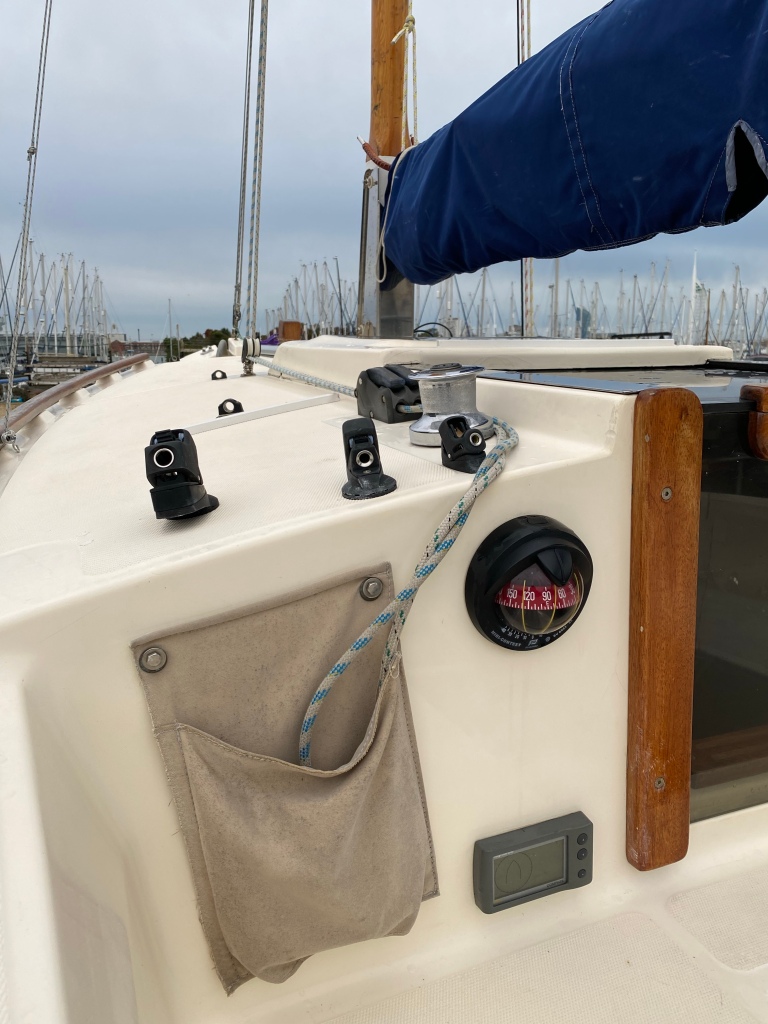

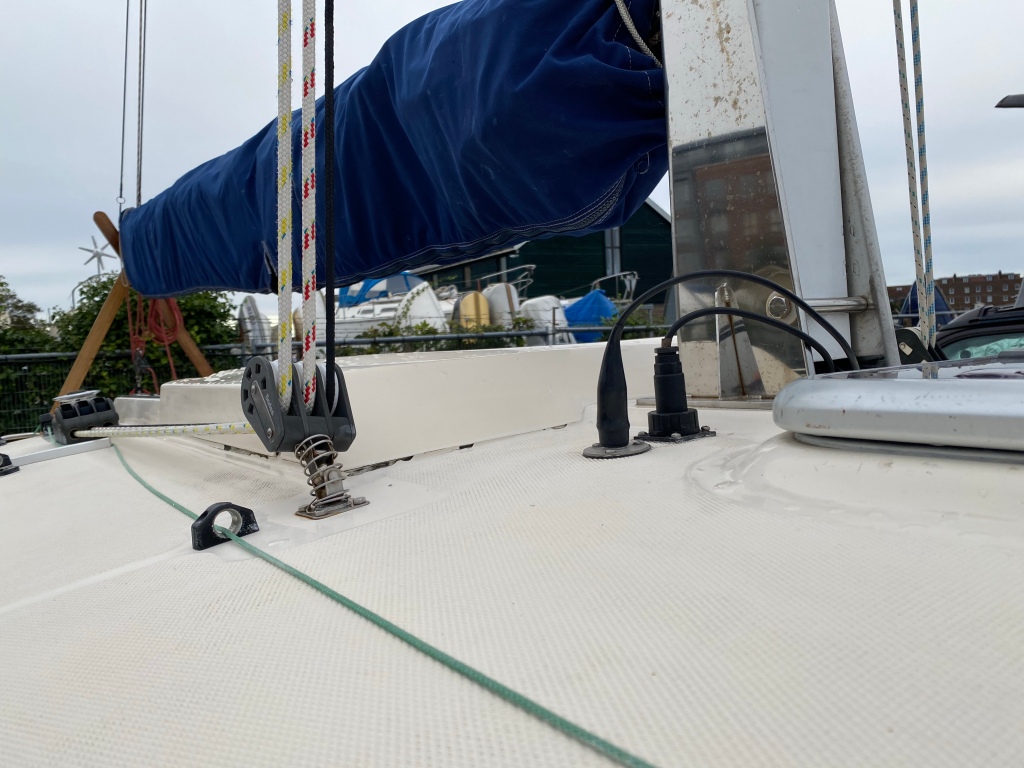
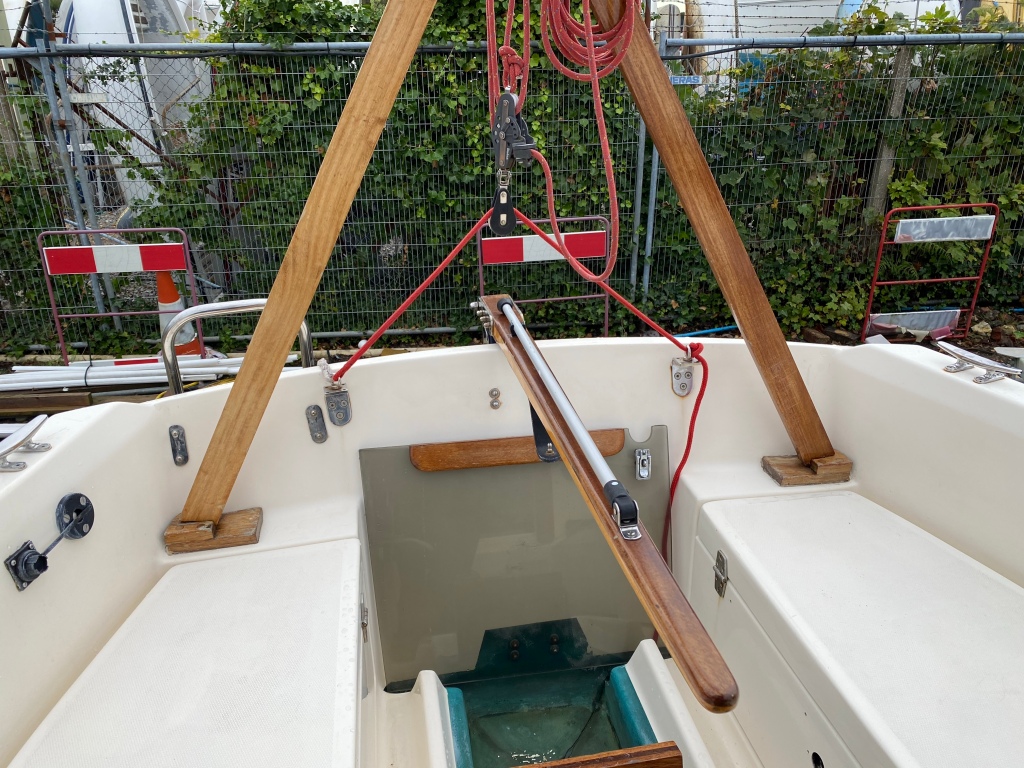


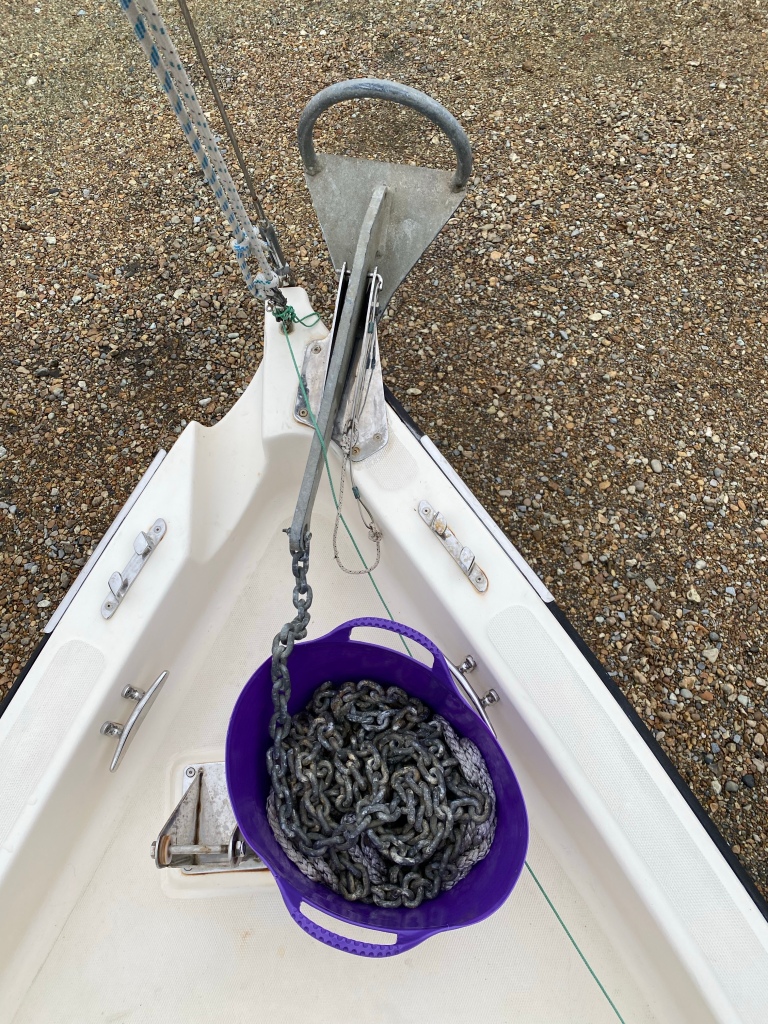
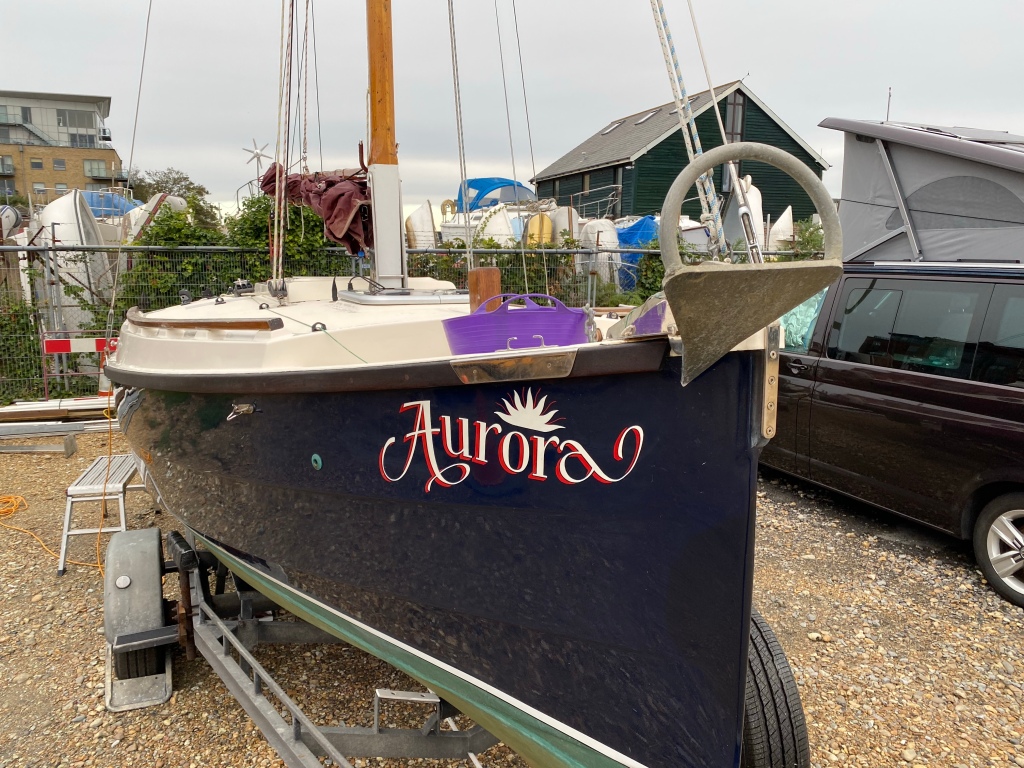
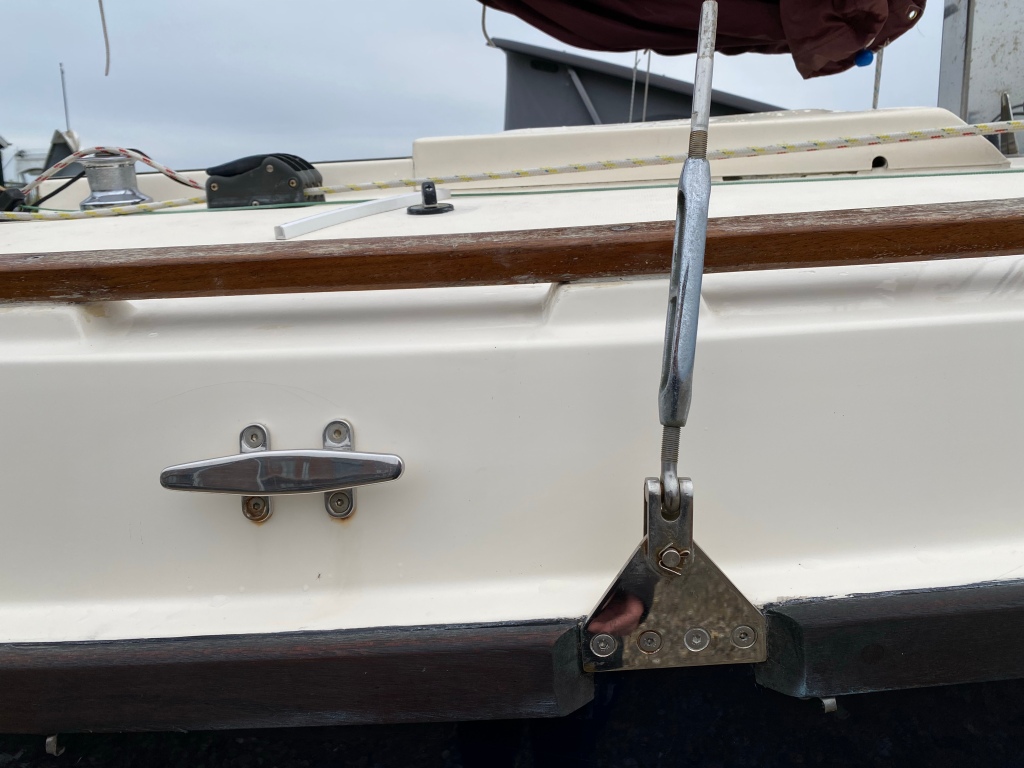
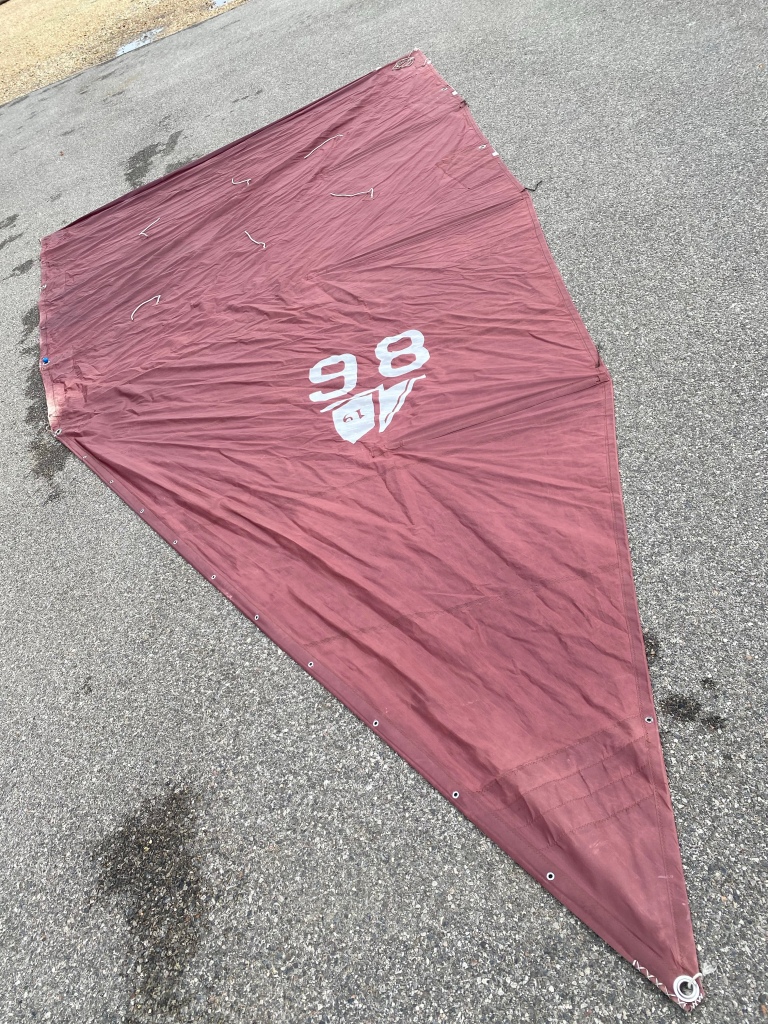


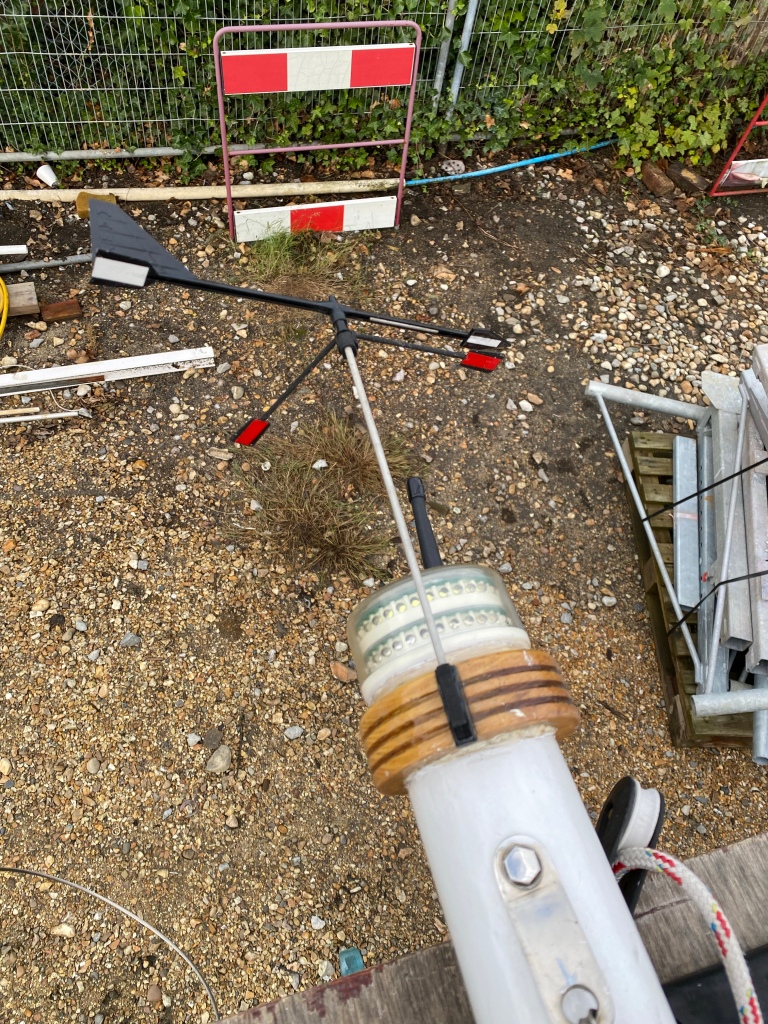

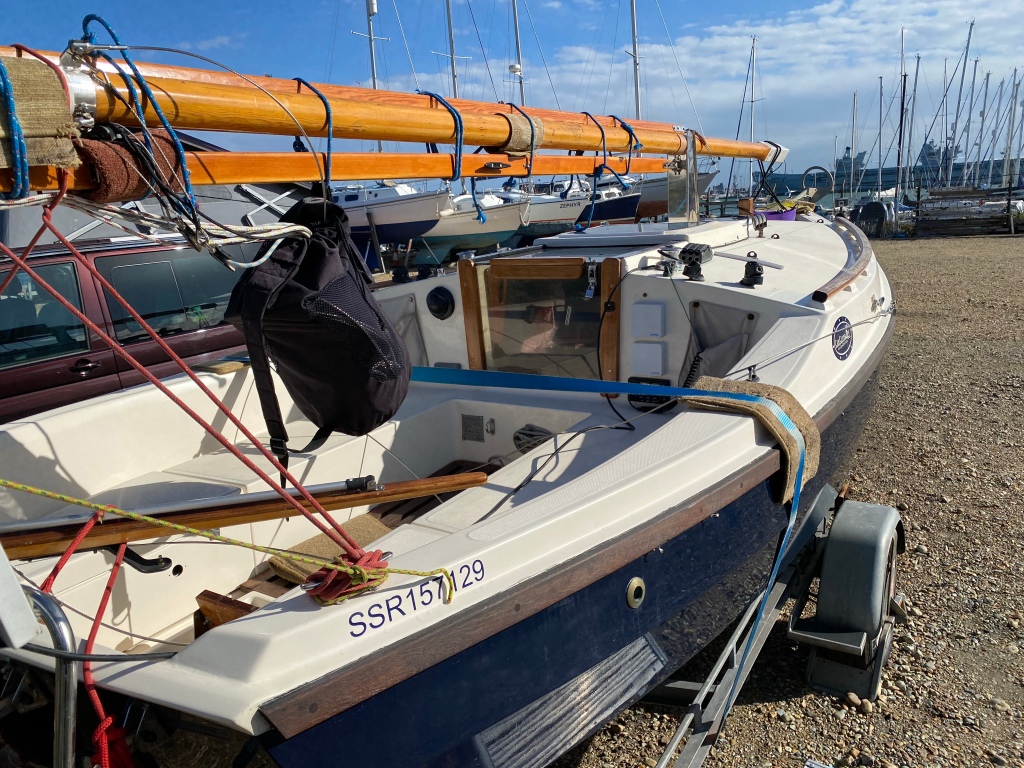


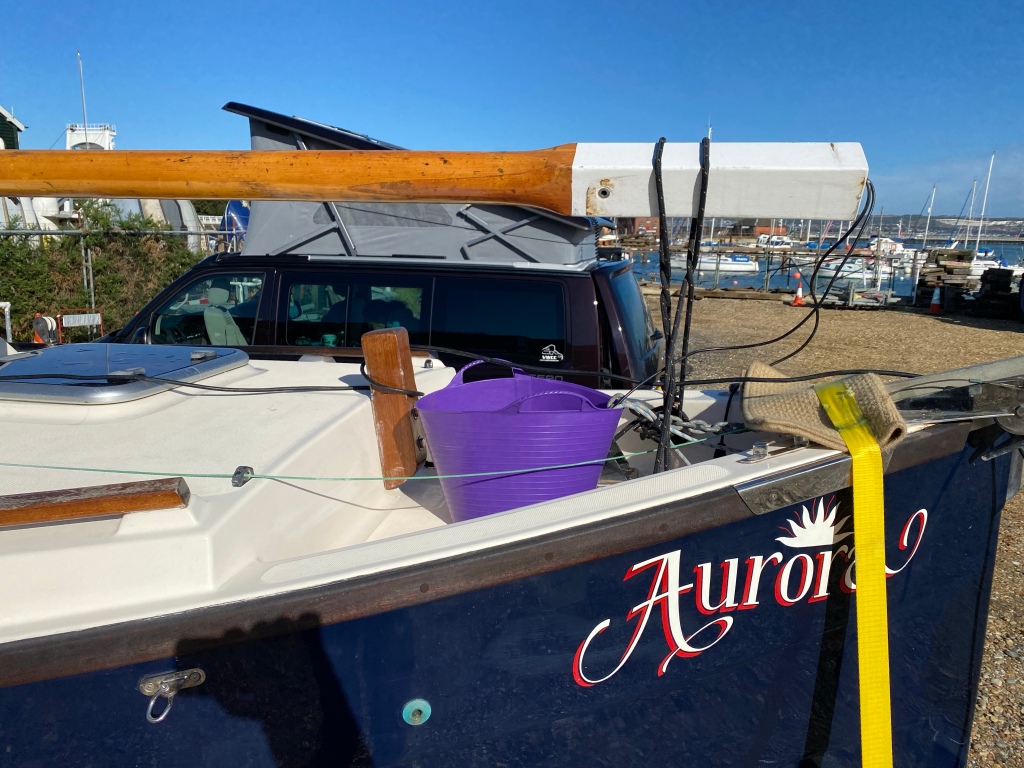
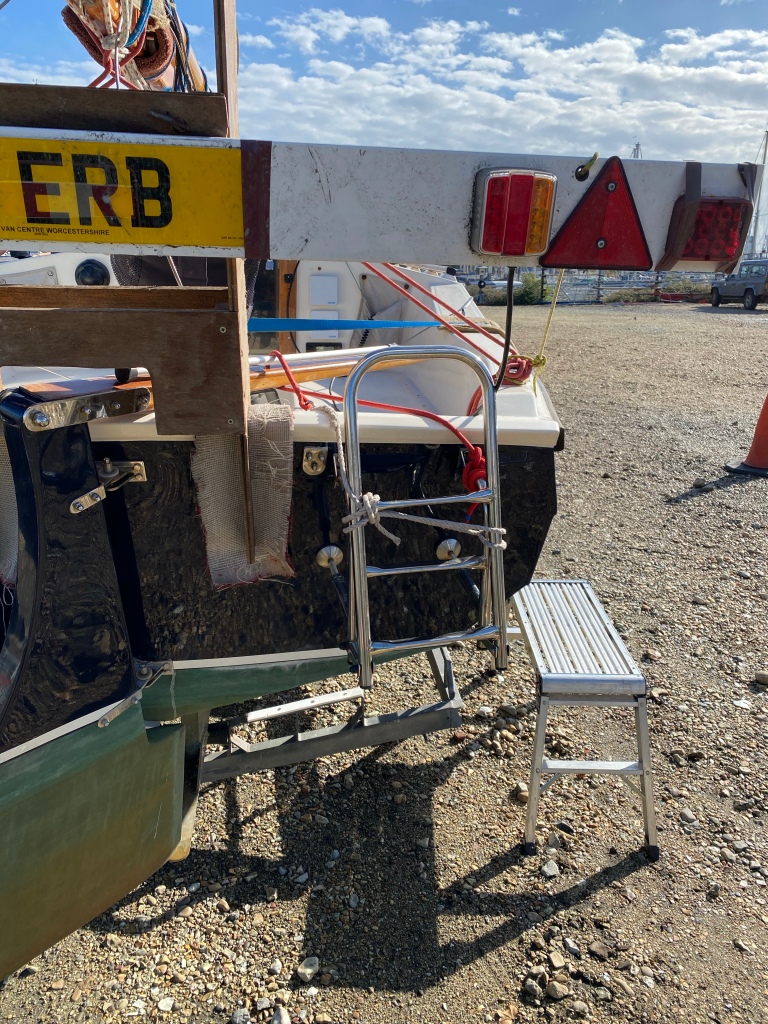
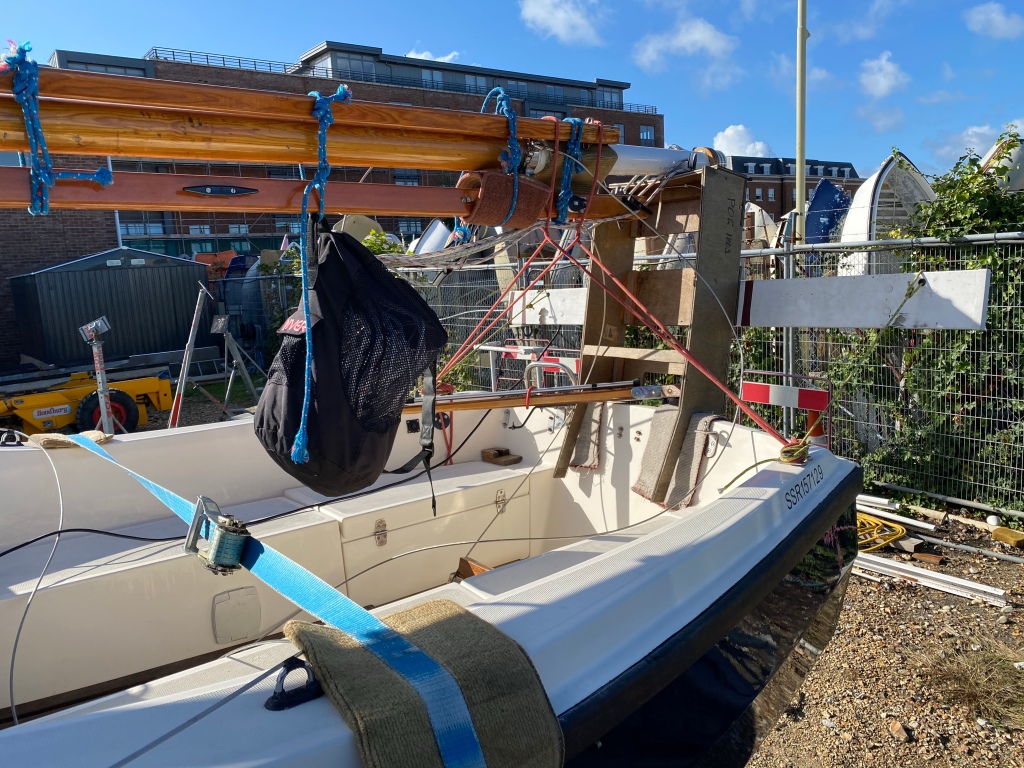
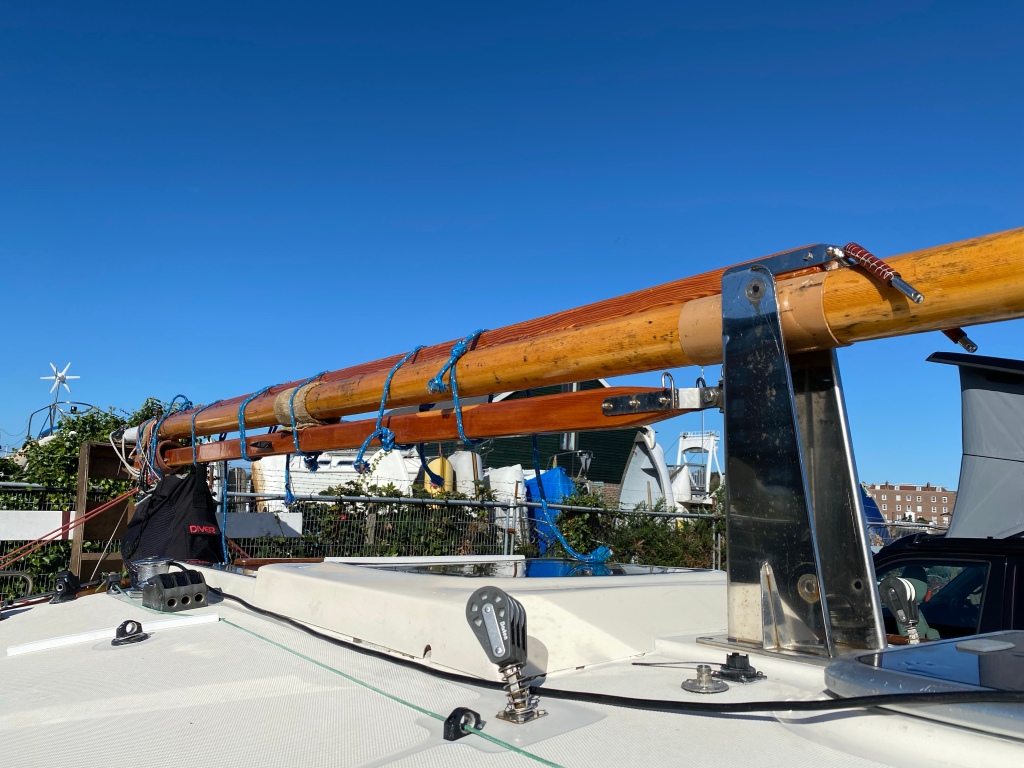
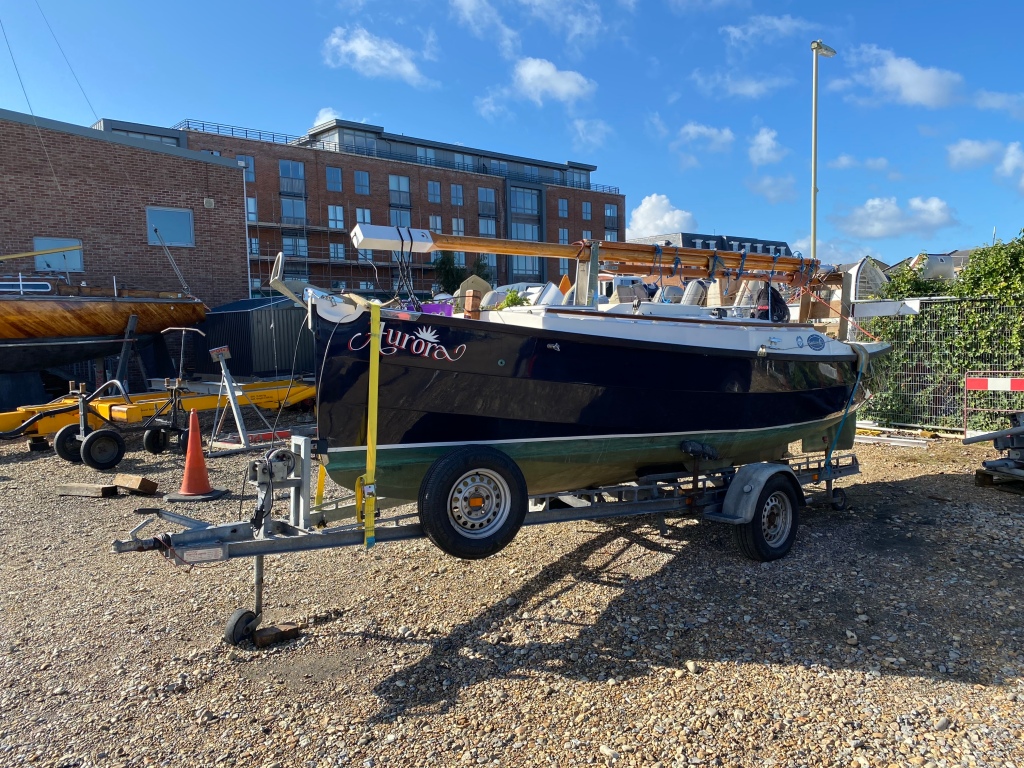
Photos showing various external features of Aurora, as well as towing preparation.



























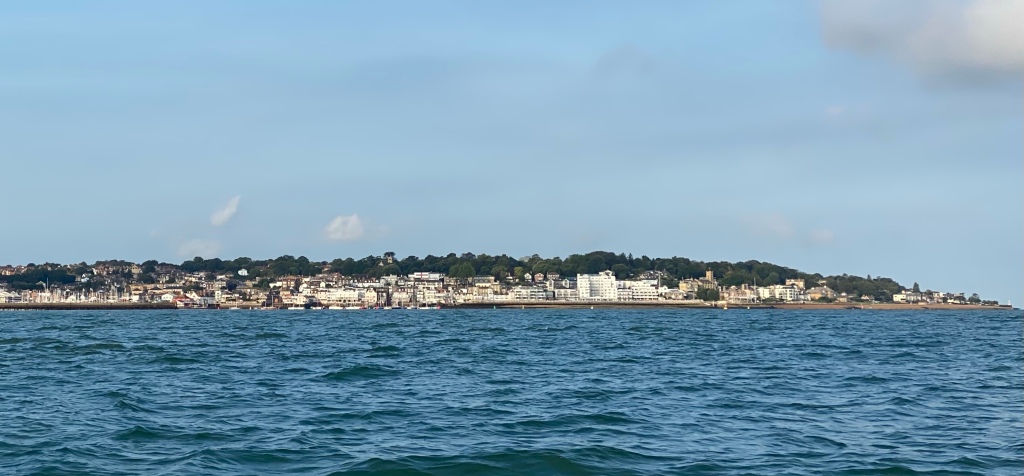
The wind had been consistently in the NE, so we knew our passage back to Gosport would be a beat. However, with the recent full moon, we had the assistance of strong spring tides. The tide was early, so I left Niki sleeping(?) down below and slipped the warps on my own. I had been concerned that it might be tricky getting off the berth, but conditions were not like they had been the previous day. For one thing, the NE wind which had rocked the boat most of the night and created the usual chorus of halyard slapping in the year, had died. For another thing, it was low water and the tide in the harbour was slack. I motored out of the Eastern entrance to the harbour and set all the sails. The first tack was to make some offing and though the wind was light, the sea was calm and Aurora moved out into the channel to catch the tide. Once I was sure that I could fetch down the island shore, I tacked away and began to move towards our destination. Progress was good, aided by about about 2kt of tide, but the wind increased from f1-2 to f3-4, with some bigger gusts. Sadly Niki came on deck just as I needed to tack and we were heeling considerably in the gusts, which she does not find comfortable. It also emerged that she had not had a good night’s sleep either, and was not enjoying the proceedings. Having tacked, I heaved to, took in the Genoa and reefed. It might have been better to have proceeded on Genoa and main only (perhaps with a reef), but discretion suggested reefed main and staysail. After all, there was plenty of tide. Aurora does not have the weight to push through even a light chop, so progress was much slower, which I alleviated by firing up Henry Honda. By the time I reached Gilkicker Point, there seemed little point in sailing on, so I dropped the sails and motored directly for the Harbour.

This was the end of our trip, but the early start gave us most of the day ashore, which gave us time to have a walk and do touristy things. It also provided Niki an opportunity to use the club sewing machine to make some repairs. She skilfully repaired the stitching on the sail cover, as well as some small fraying to the boom tent and even to rescue the rather worn Cape Cutter Association burgee.
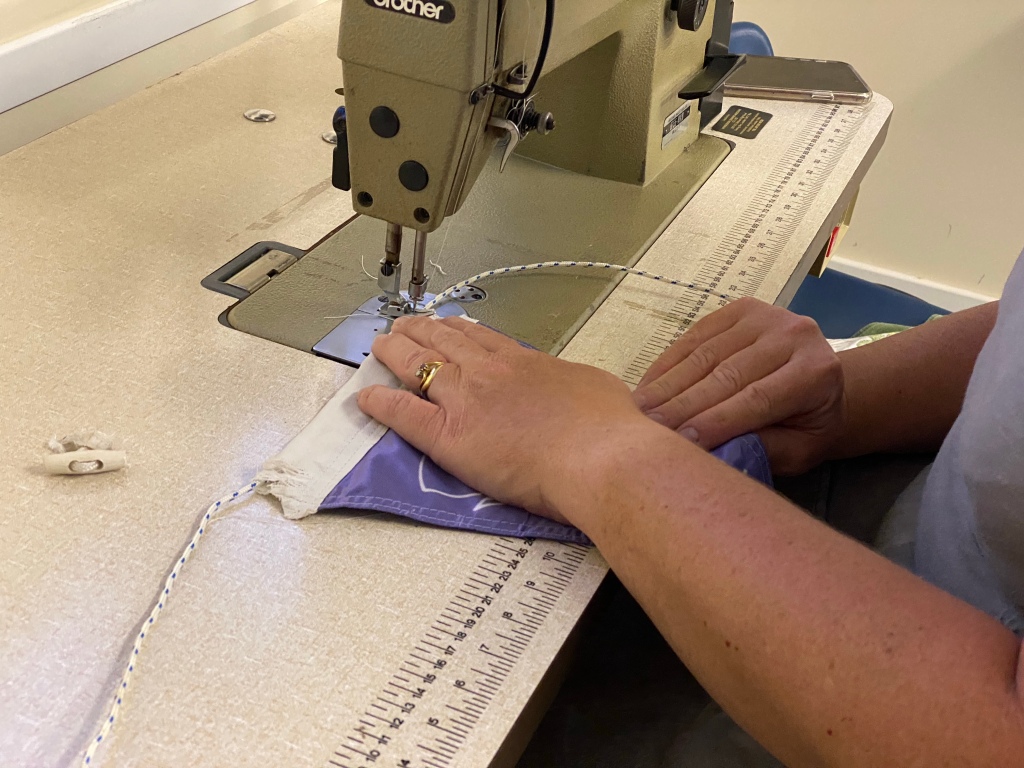
With the wind set in the northeast, Cowes was the most sensible destination, being a simple run down from the Hamble. It’s a short distance and Niki fancied a wander around the shops. Although Hamble Point marina seemed quiet, there was a bit of Hamble Scramble”, with a procession of boats making their way out through the narrow mouth. There are five marinas and countless moorings in that two-mile stretch of water, so there’s always a lot of traffic.
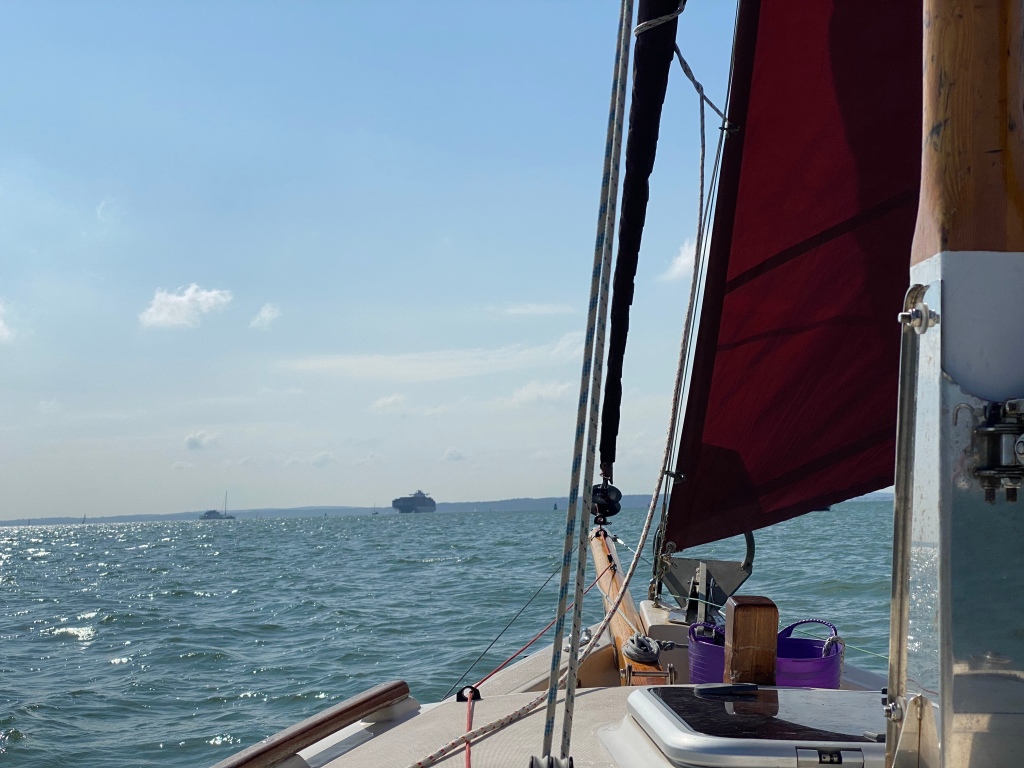
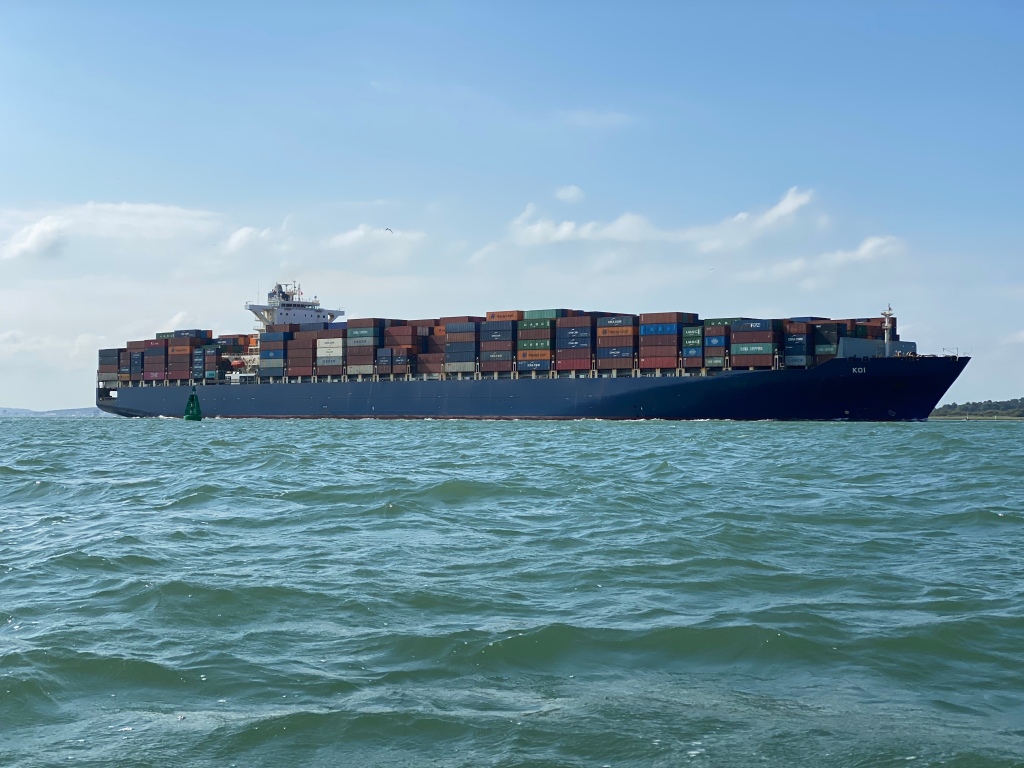
Once in Southampton Water, it varies between a training run and a reach down towards the Solent. We were entertained by the flotilla of little dinghies in the sailing school at Calshot, commercial shipping, ubiquitous ferries and numerous pleasure craft. The water was rather choppy and confused with wind over tide but we made good progress with reefed main and staysail only.
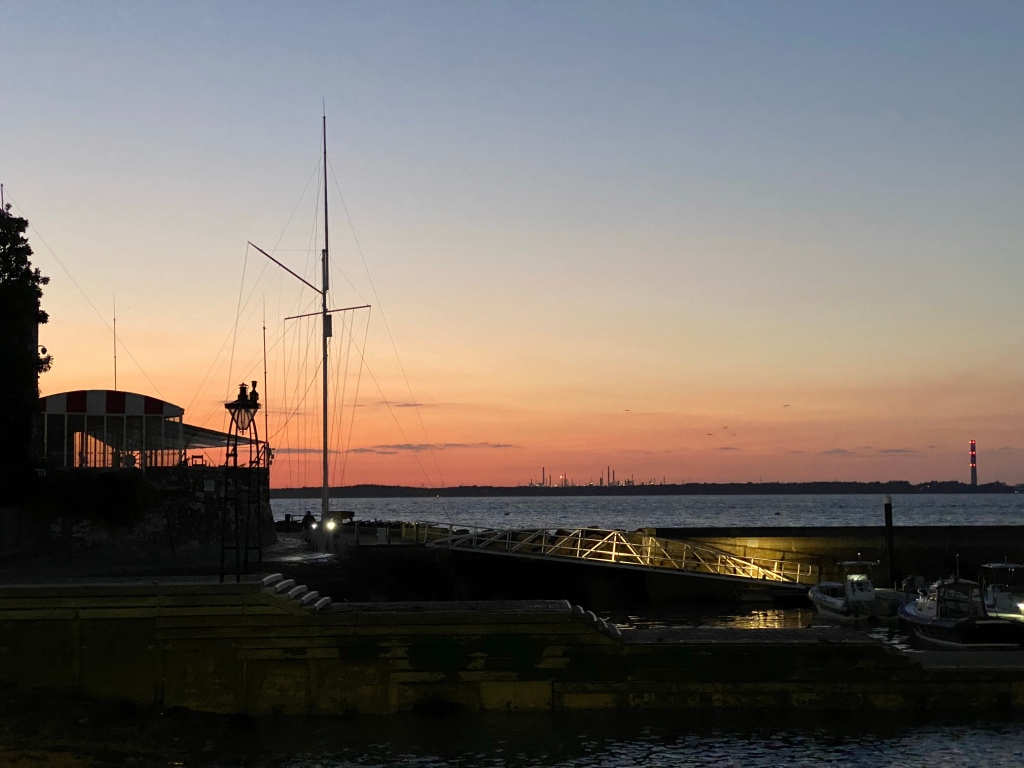
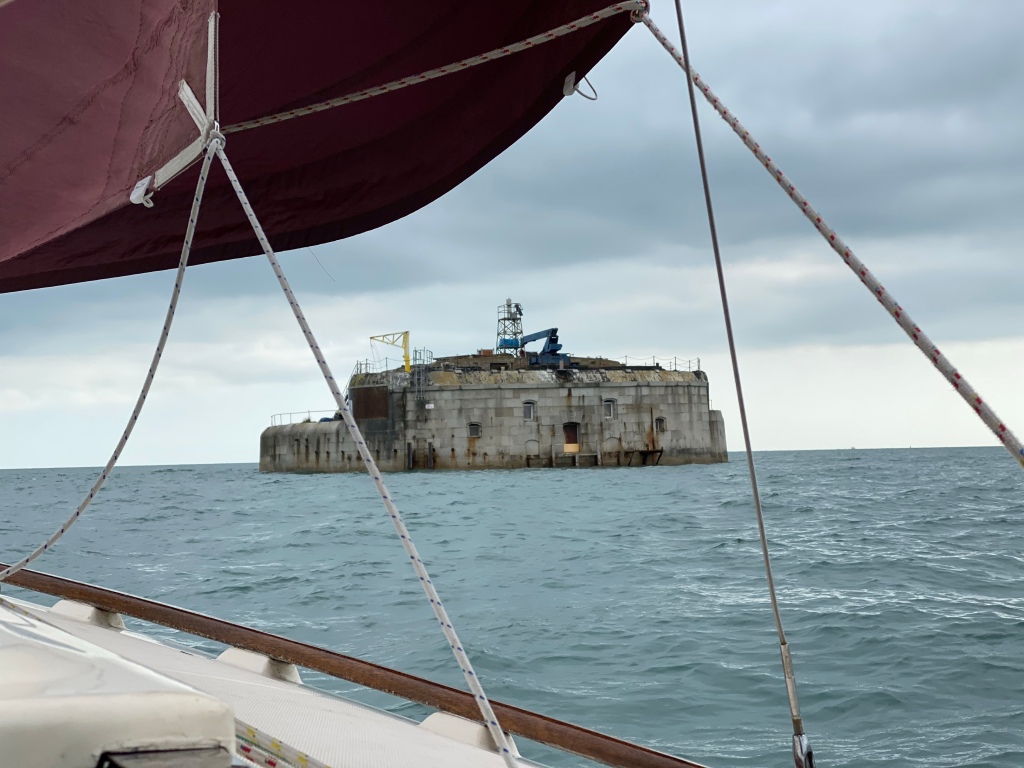
We’ve been sailing in the Solent area on and off for the whole time we’ve had Aurora, but have never been up Southampton water. Most of our passages have been East-West, but the North-Easterly currently prevailing makes North-South passages more appropriate.
So it was we went to Bembridge yesterday and chose the Hamble as our destination today. Matt, skipper of Skylark, has his berth on the Hamble and gave us some encouraging recommendations.

We left Bembridge as soon in the morning as there was sufficient water for us over the bar, which meant we left before the main procession. Having motored out into the main channel we hoisted all the canvas in the NE f3-4 and beat clear of the shore and then fetched past the edge of Ryde sand. At this point we were able to bear away onto a comfortable reach, which took us right across the shipping channel, past Gilkicker point and along the shore by Lee-on-Solent. It was just as well we were on a favourable point of sail in smooth water because the wind had moderated somewhat. Nevertheless we made a steady 6kt with about a knot of tide under us and enjoyed the views over Southampton water, with beach huts on the eastern shore and the industrial vista of Fawley oil refinery on the western side.
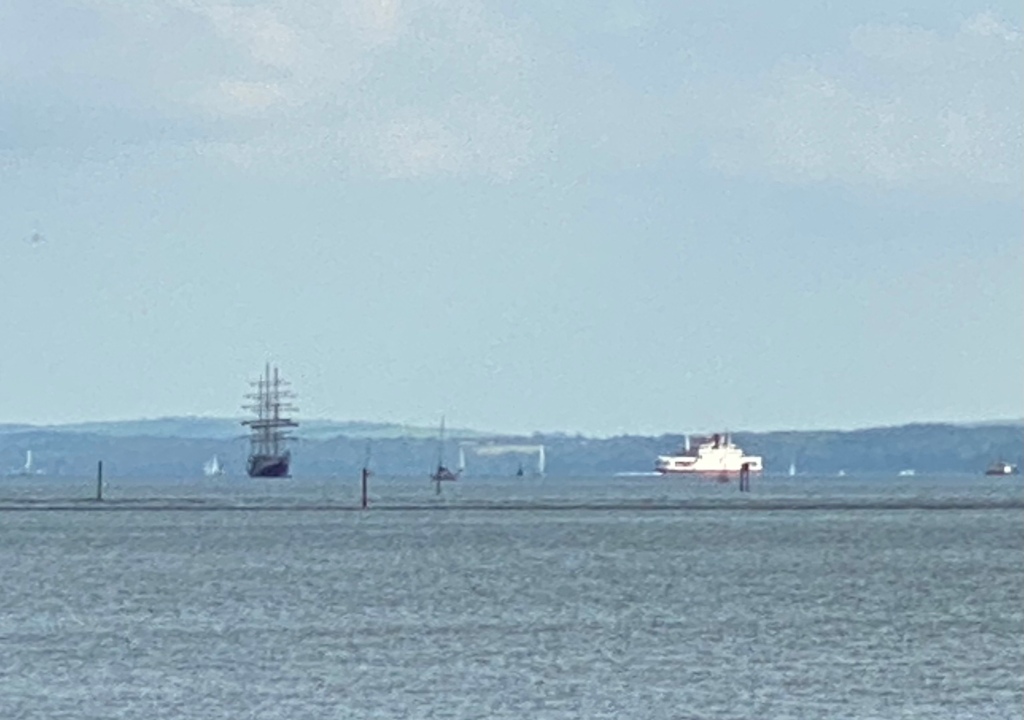
We spotted the square rigger Tenacious on her mooring; she had been out and about in the distance at the weekend. We could see that most of her yards did not have sails, so she would sail on no more than two courses and topsails, though we hadn’t spotted her with more than one sail set. I wonder how many crew she needs to set the sails? Perhaps that’s why she seemed to be mostly under motor.
On reaching the mouth of the Hamble, we began to beat up the channel, but the strong ebb made for particularly slow progress, so we proceeded on engine. Once in Hamble point marina, which seemed quiet, we were able to enjoy some much welcome sun, after a hitherto rather grey and cool day, followed by a pleasant woodland walk into the village and a lovely dinner at the Victory pub.
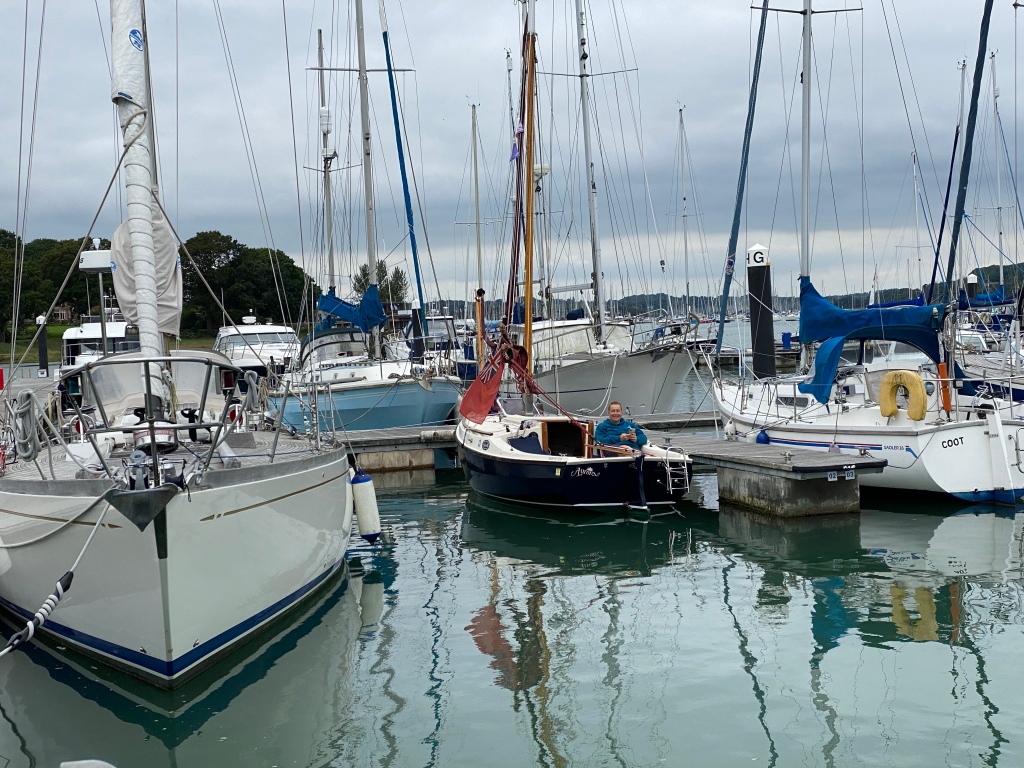
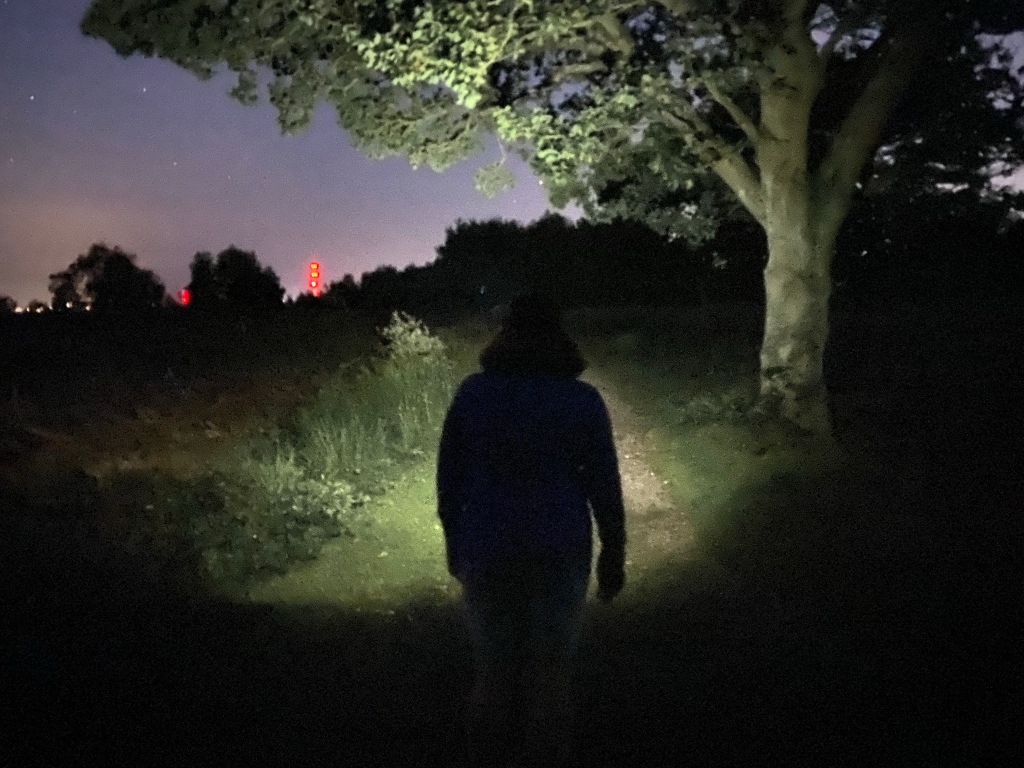
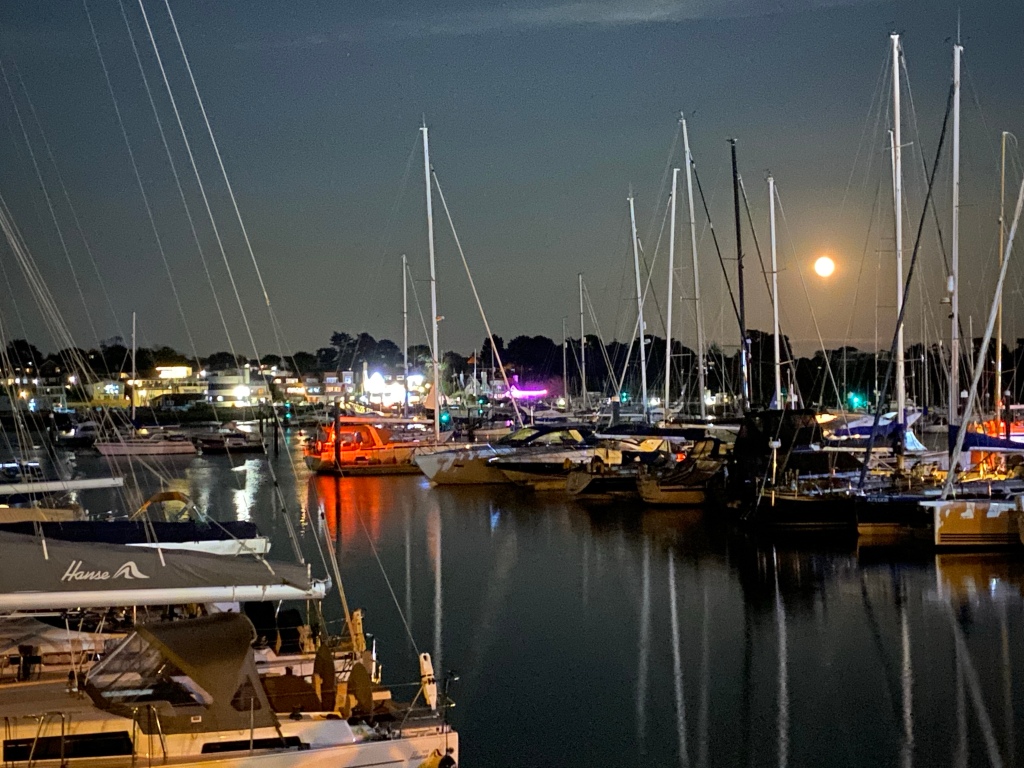
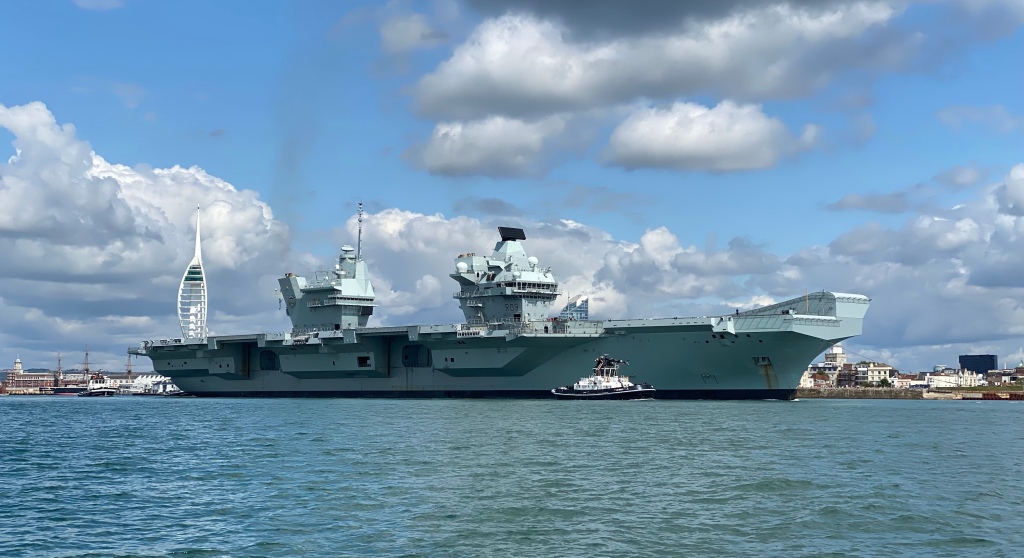
We were pleased to meet up with fellow Cape Cutter Skylark in Bembridge. As we left Portsmouth, we were treated to the spectacle of the aircraft carrier HMS Prince of Wales leaving port. I had heard a “pan pan” warning that the channel would be closed, and as we nipped out, police boats were stopping traffic coming in and we were among the lash boats allowed out.
Niki helmed us reaching back and forth among the many other boats in the shallow area south of the channel waiting to see the carrier squeeze through the narrow harbour entrance.
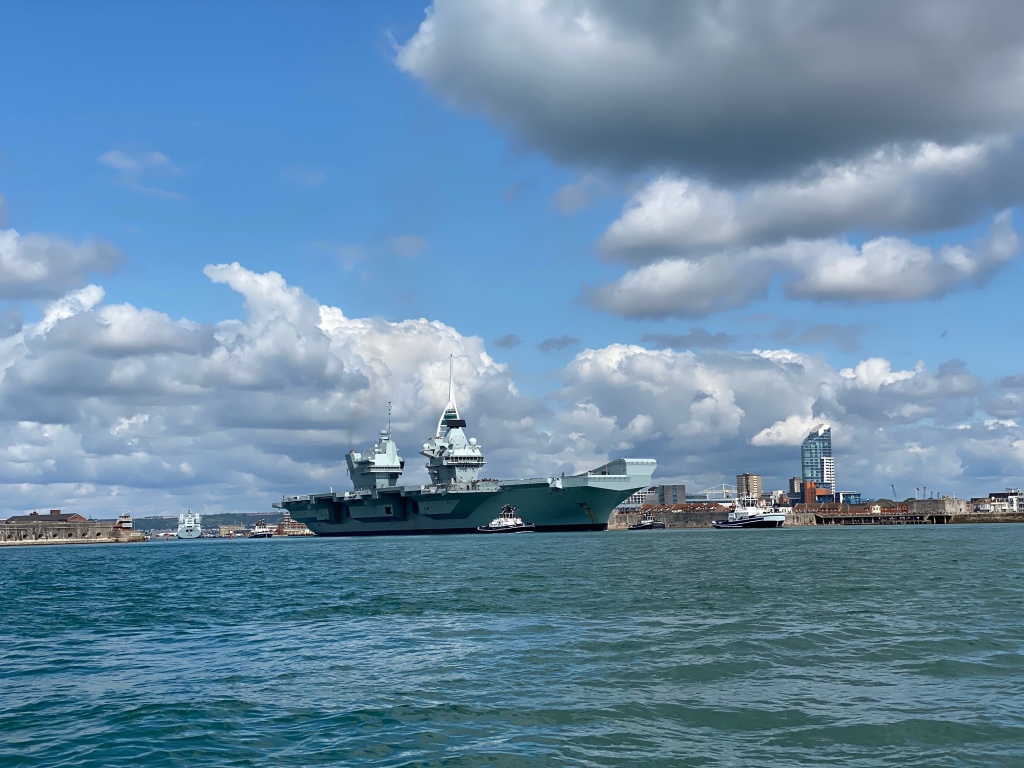
The previous day, we had visited the excellent Portsmouth museum and I was fascinated to discover that in the great days of sail, warships would have their guns unshipped in order to pass into harbour, which is why the fleet would usually anchor outside at Spithead off Ryde. It was a lovely thought that this most modern of warships would pass out of the same narrow passage at high tide as it’s illustrious predecessors such as Nelson’s Victory with lies within sight of Prince of Wales.
The carrier left harbour assisted by a fleet of tug boats and all other shipping paused. The island ferry paused and even a large container ship held far out in the main channel. Prince of Wales made a fine sight as she emerged and soon moved off, leaving traffic to return to normal.
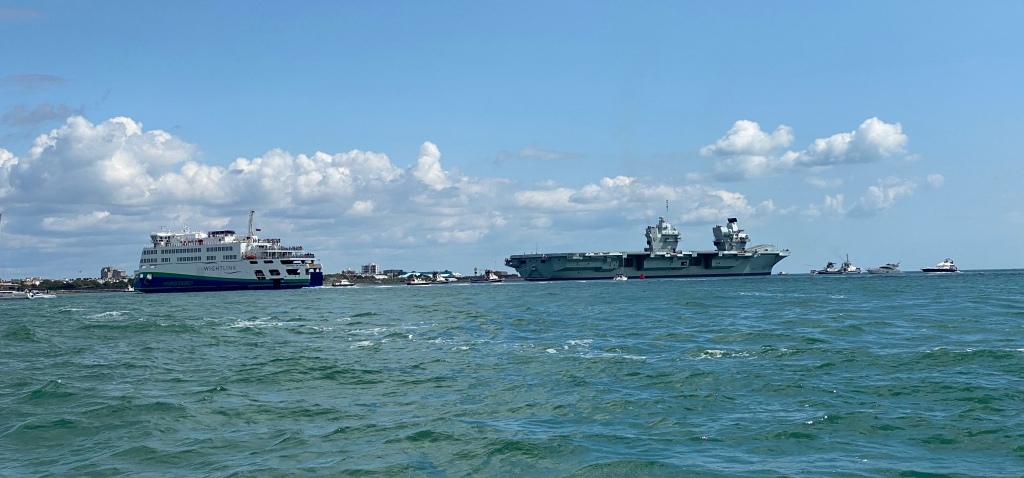
We had a fine sail down to Bembridge – a training run with all three sails. We were able to sail our way all through the channel right into the inner harbour before motoring to find our berth on the far side of the pontoon and meet up with Matt, skipper of Skylark.
We spent a sunny afternoon chatting in the cockpit as the water drained away around us to reveal the mud and signal dinner time for the waiting birds. We had our own dinner at the Vine pub, after a pleasant walk along the stone wall across the lagoon and up the hill into the village.
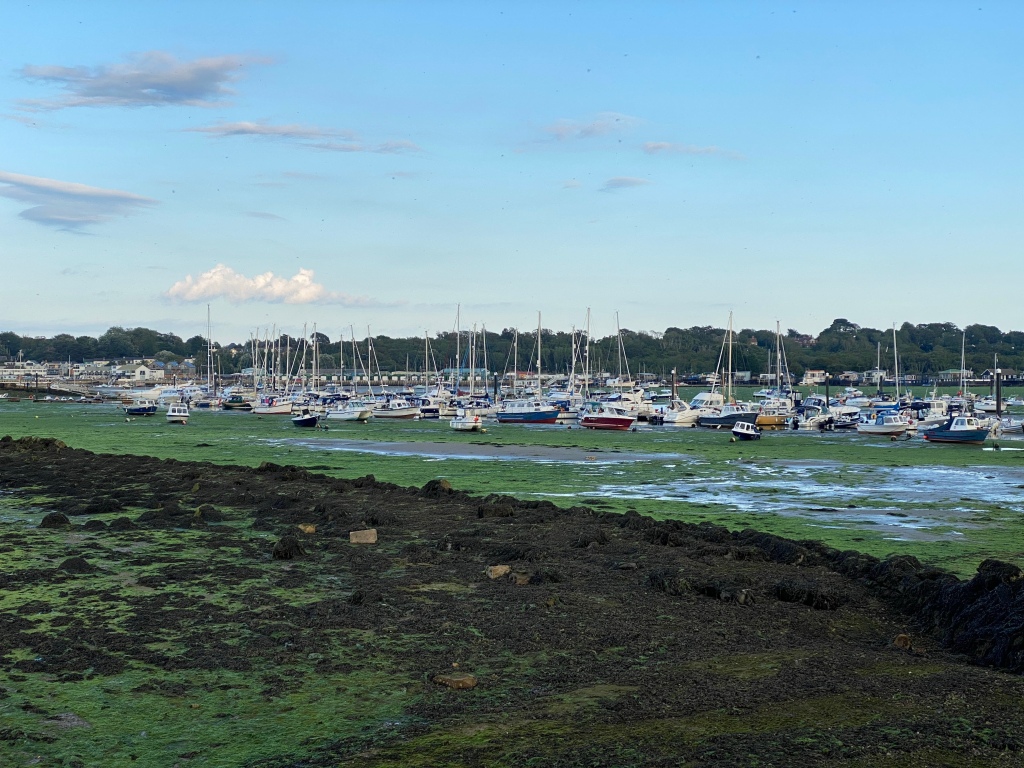
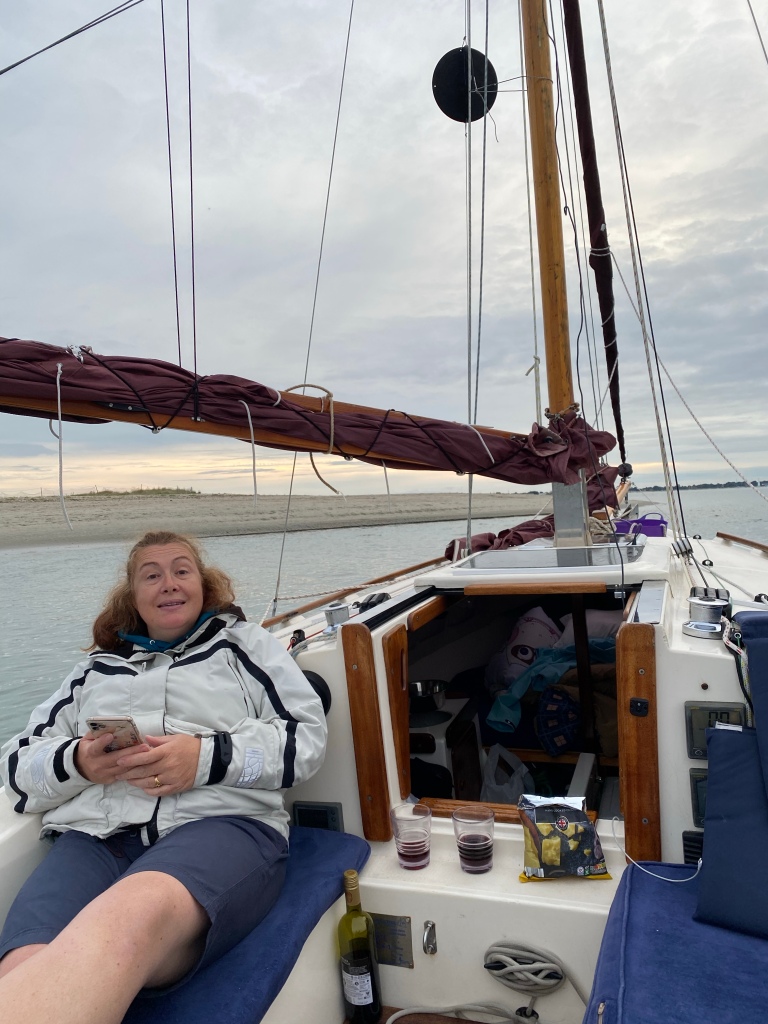
East Head is one of our favourite anchorage sites- its only a couple of hours sail from our home berth and is a serene and beautiful site. Last night we had a wonderful downwind sail in a gentle F2-3 and ghosted into Chichester harbour. Choosing our favoured spot to drop the anchor, Niki expertly helmed us into position under sail, so we don’t need to fire up Henry Honda.
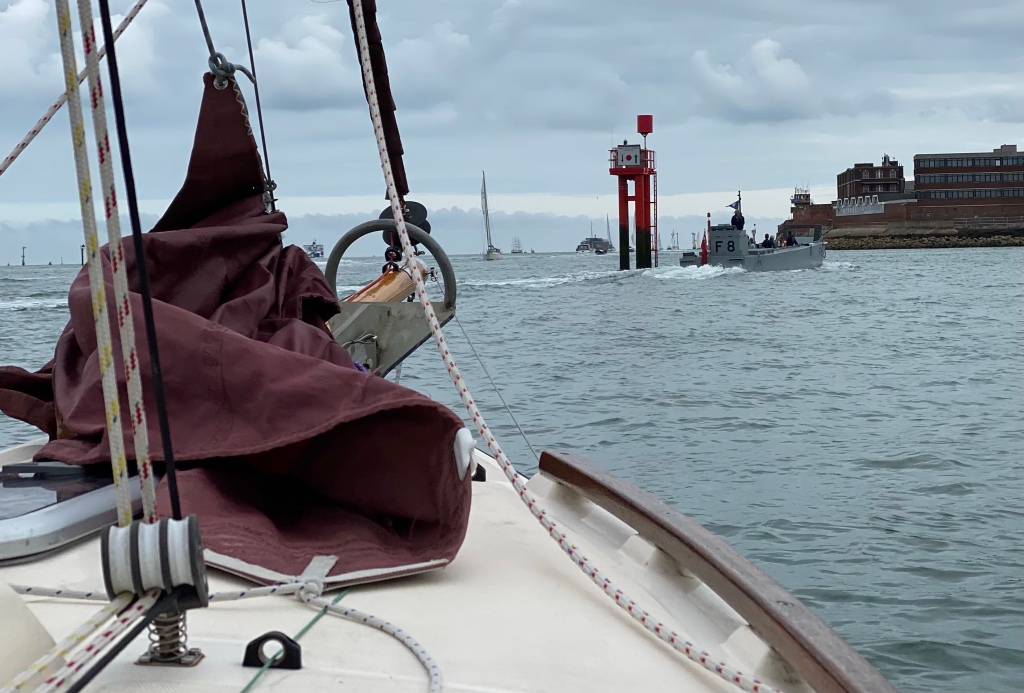
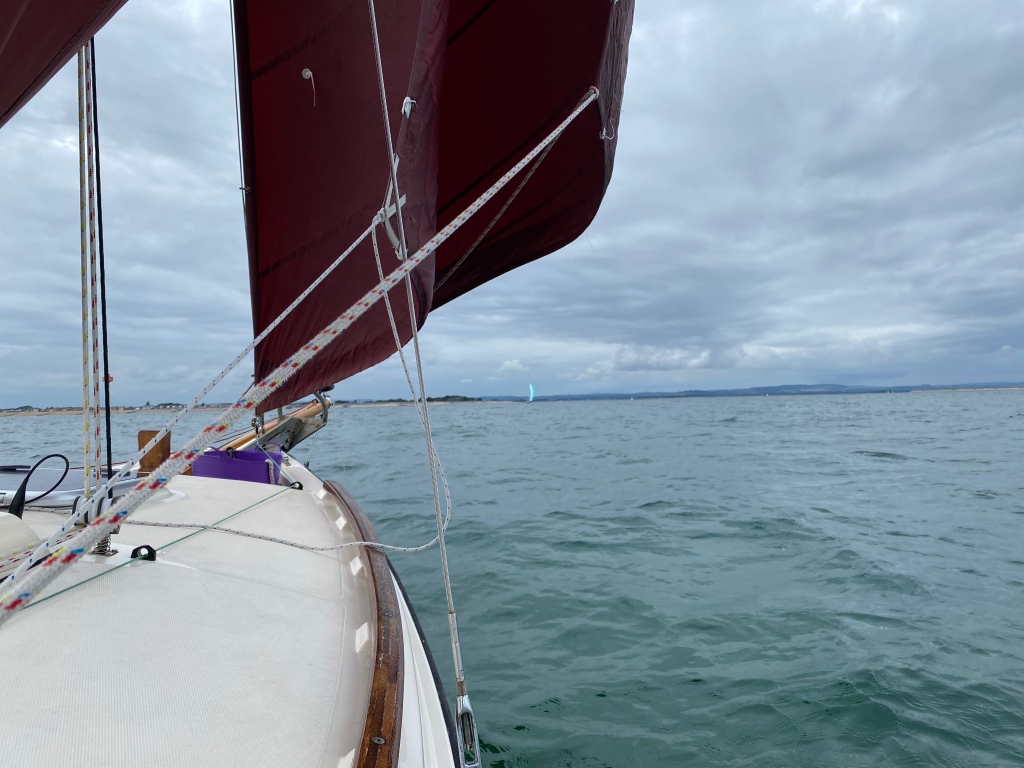
The anchor on the Cape Cutter gives great holding and we felt very secure, just feet from the edge of the sand. It was a lovely evening to drink a couple of glasses of wine, watching the night fall. We could hear the birds around us and the gentle rippling of the water.

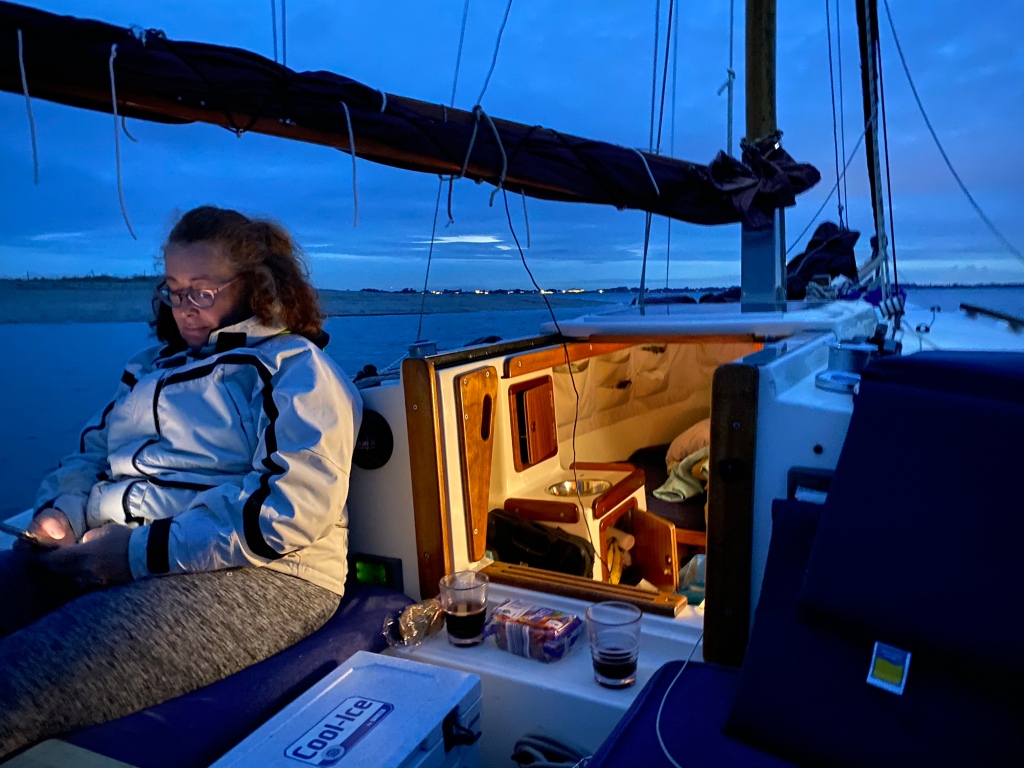
There was a fair bit of traffic mid-evening which made us roll from time to time, but after that it was supremely peaceful – the light wind died completely and the water’s surface was mirror smooth reflecting the lights on the boats at anchor. The full moon rose late in the night and all I could hear was the sound of water flowing gently under the hull and the ever present sound of distant waders.
I awoke early, just after the tide turned. We had just touched the bottom at low tide but by the time I was ready to leave, there was plenty of water. Niki repeated her helming trick and we sailed off with troubling Henry again. The wind had swung round to the SE but was very light, so progress was very slow at a dead run. Niki went back to bed and I persevered for a couple of miles and then put the engine on and motored back to our berth.

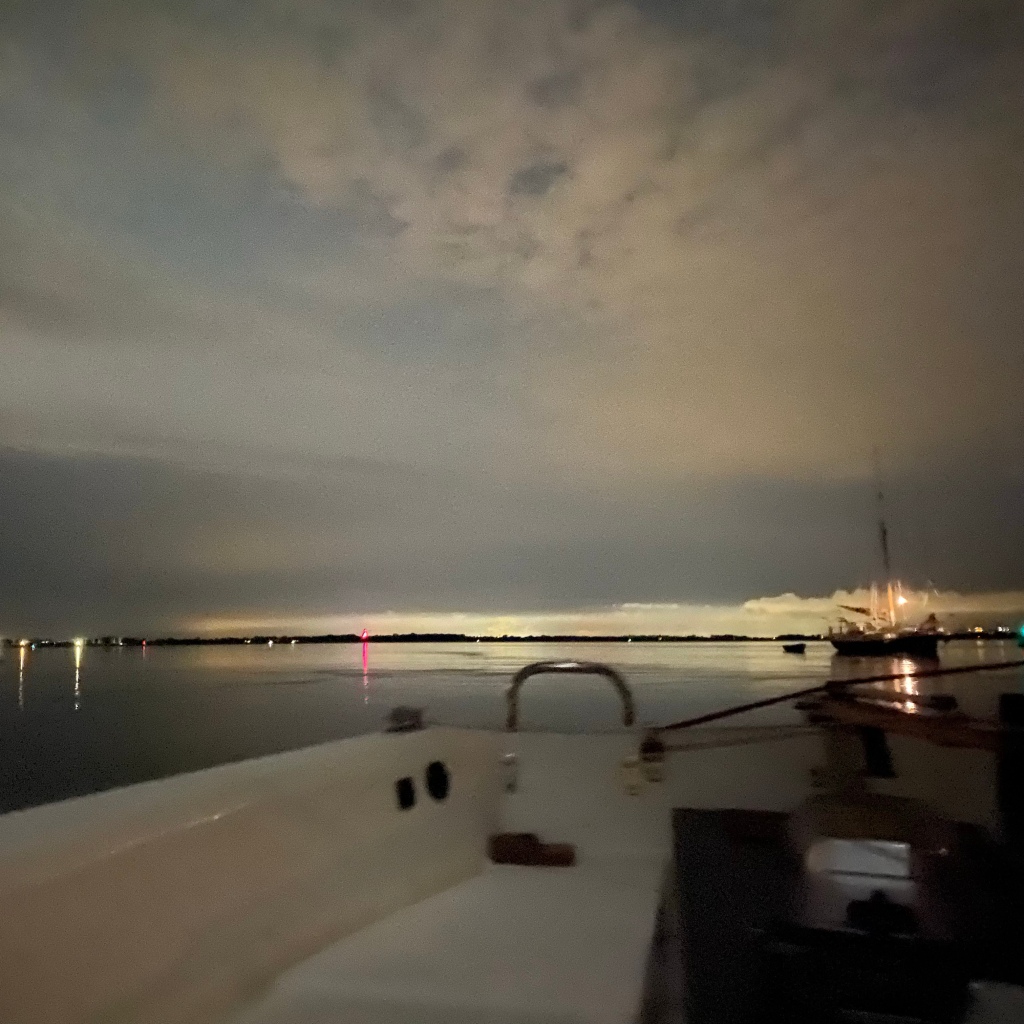

It was our pleasure that Aimee asked to join Niki and I for a short trip, bringing her friend Shore, who had never sailed before. Aimee prefers a lively breeze and was not disappointed on this trip. The four of us left Portsmouth in late afternoon and caught the ebb down to Cowes.
The wind was whistling in the marina, so we set out with a reef, but shook it out before we reached Gilkicker point. The wind was a F4-5 SW, so we ended up beating on full main and staysail. The Solent was very busy, though the weather was disappointing for August. Aimee helmed for a good portion of the way and then passed on some of her skill to Shore, who took to it really well.
It’s interesting how much difference four people make to the amount of sail Aurora will carry. Sailing upwind, the most comfortable arrangement is for three to sit on the windward side and the fourth to sit on the companionway step. The result is that Aurora can carry full main, when usually a reef would be needed.
Cowes offers the option of a number of marinas and this was just as well, as the first couple we tried had “no room at the inn”. Fortunately, East Cowes Marina had a space for us and we gratefully tied up and found our way to a curry house for our meal.

The next morning needed a snappy start, to vacate our spot (the berth holder arrived back just as we were leaving) and the plan was to travel to Yarmouth via Newtown Creek for lunch, but the weather was grey and drizzly, so we decided to make straight for Yarmouth. I was hoping the forecast WNW would let us fetch along the shore, but sadly the wind persisted in the SW, so we had a beat back and forth between the island and the mainland. The wind picked up to F6, so it was a spirited sail initially on full main and staysail and then reefed main and staysail.
The Solent was thick with yachts beating to westward and it was lovely to see so many boats out. Above us, we were treated to two low passes of the air-sea rescue helicopter, as well as a Spitfire performing aeros.

There were many power boats out too – we watched a big power boat motor upwind less than 10m from a yacht sailing downwind, leaving the yacht thrashing in its wake with spinnaker tangled round forestay. I’m often struck how some power boat helms seem oblivious to the impact of their wake on other boaters – a small course correction to avoid such a close pass makes little difference to them but has a big impact on sail craft.
On entering Yarmouth harbour, we were led to a convenient spot by the berthing master and were able to dry out our damp gear, whilst we had lunch, followed by a restful afternoon. Shore tried his luck fishing off the pier, but did not have any luck. Sadly there was some water down below which had wet the quarterberth cushions – the outboard bracket had vibrated loose (in fact one nut had dropped off into the scuppers!). I tightened them up and hopefully we’ll be dry after this, though we could wish for more sun to dry things out.

Yarmouth was very busy – this is the “staycation summer” and everywhere was packed. It took us a while to find a restaurant with space for us, but we were very pleased to get a table at Cucina, where we rounded the day off with some good seafood.
The following day saw our return to Gosport and I was relieved that the wind had remained in the west, so we would enjoy some downwind sailing after all our beating. The east-flowing flood tide was not until the afternoon, so we decided to work against the tide as far as Newtown Creek, eat lunch and wait for the tide to turn.
Despite the neap tides, there was still a considerable foul tide to work against in the light winds and we crept along close to the shore, out of the strongest tide, deep downwind on full main and engine at low revs.

None of the other crew had visited Newtown Creek before, so I was keen for them to see it. However, the weather was grey and rather drizzly, so it wasn’t at its best. Nevertheless, it was a relaxing time to watch the water ebb away and the mud banks emerge from the waters, seals haul out and waders strut about probing for food. Shore spent some time fishing, but succeeded in catching only sea squirts, despite using several different rigs. The fat seals resting on the bank nearby kept waving their fins to encourage him, but to no avail!


By the time low tide had passed, the weather had brightened somewhat and we had a fast and very enjoyable sail downwind and down tide. The Solent was busy and I love watching all the activity around us as we sail along. Just as we watched many yachts beating the previous day, today we could see an armada of yachts running in the same direction as us; some on genoa only, others goose winged but relatively few with spinnaker. We also saw a couple of large container ships in and out of Southampton water, one smaller ship passing quite close.

We sailed much of the way on main only; I keep meaning to make a whisker pole, which would have been useful to pole out a jib. However Aurora made over 6kt the whole way, so we had no complaints for speed. We made great time back to our home berth and rewarded ourselves with a fish and chip dinner.


It was with great pleasure that we travelled to beautiful Northumberland to visit Kielder Water with Aurora. This was to be be second gathering of Cape Cutters in 2021 and, despite being a long way to tow for a long weekend, it was well worth the effort!
We were the guests of Kielder Yacht Club, who have pontoon berths, a good slipway and a comfortable club house. Kielder Water, opened in 1981, is the largest artificial lake in Britain (by volume) and is surrounded by lovely forest. Its remote location makes it a haven for wildlife and is a superb “dark sky” location. The lake’s winding shape and 27 miles of shoreline, make it an interesting inland location for sailing.
We travellers (Aurora, Iris and Rondo from the Midland area, Wadudu from Devon, Sapphire from Dorset and Tystie from Cumbria) arrived on Thursday evening for a barbecue, guests of Gary Oldfield, skipper of Moneypenny.

We moved to KYC on Friday morning to join the four local boats, for a leisurely rig up and shakedown sail. I must admit, Aurora’s “shake down” was rather short and would be better described as picking up a mooring, sunbathing and swimming!

The main event of Saturday was a “treasure hunt” cruise of the lake, to find clues attached to various buoys. These clues formed a hidden phrase; I think we all got the clues, but only Katie on Tystie and Tony on Wadudu managed to solve the riddle – I couldn’t work it out, but kicked myself afterwards (its always easy when you know the answer!).

At the end of that we all rafted up together in one of the sheltered coves – a record raft on fresh water of ten boats (we managed eleven at the Solent Rally earlier this year). The day was finished off by a tasty barbecue at the clubhouse, whilst we watched the sun set over our fleet dressed all over.



On Sunday, Matt Bridger laid on a race for us. I am not a very competitive sailor, but its very enjoyable to sail against others in an identical boat, and compare the effect of various settings. The day was quite light, but there was a little more than the very light airs forecast. Most boats made a fairly creditable start and, helmed by Niki, we beat up towards the first mark near the dam wall. Iris made an almost perfect start and steadily pulled away from the fleet to round the windward mark some time before everyone else. Aurora was second around the mark, followed by Tystie and a tight bunch of others.



The wind dropped as we made our long run back down the lake, so everyone’s downwind technique was tested. Tystie turned out to be especially slippery and glided past us with staysail and main both pulling – we could only manage to fill our main. Meanwhile, Richard seemed to be having trouble keeping enough wind to keep Iris moving and we could see sails wrinkling in the distance. The rest of the fleet closed up on him and Tystie made a near perfect roll around the mark and set off back up the lake. The run had become a reach by the time we approached the mark and so it was a beat back to the finish.

Aurora and one or two others also took Iris at the mark, but it was Tystie’s turn to romp off into the distance. Aurora held second position from Rondo and Moneypenny, the latter showing a lot of her “bottom” in the gusts. This was typical lake sailing with the wind shifting often and care needed to find as many gusts as possible and avoid the dead spots.

The final mark was tricky, as it lay in a sheltered location and required a close-hauled approach but with very little wind. We watched Tystie tack off but not quite lay the mark, though she had so much distance on us that there was no doubt she would cross the line first. Rondo was close on our heels as we tacked off and she was pointing noticeably higher than us. Sadly, we ended up pinching and losing a lot of way. This allowed Rondo to slide past and cross the line second, with us a close third.


When all had finished, we rafted up again for a race debrief before repairing to the clubhouse for awards and votes of thanks, followed by a delicious Sunday roast at a local pub. I was encouraged that Adam Bridger, who had organised the event, described it as the inaugural Kielder Cape Cutter Rally – we look forward to a an opportunity to return in the future!


All good things come to an end, and we had to sail Aurora to her mooring in Gosport. Very light winds were forecast, so going with a fair tide was important and this, as the moon dictated, made for a very early start.
So it was that I quietly rose at 4am and carefully crossed the other boats on our raft, slipped the warps and motored out of Yarmouth harbour. It was a grey half-light and very still. The water was smooth, except for small ripples of the tide, just beginning to run. I got the sails up, killed the motor and peace descended. It felt as though we were stationary and the world was slowly drifting past me, the others remaining asleep below.
I was a little concerned that the visibility was very poor (about 200m), so I would have little visual warning of any obstruction, though sounds carried from much further away. I could clearly hear the dawn chorus of birds in the trees on the island and even the sound of some lads arguing good naturedly on an unseen anchored boat in the mist. At one point a large cargo vessel loomed silently out of the mist and appeared to be bearing down on me, until I realised it was anchored.

When we passed Cowes, the point of sail was not so deep, but the wind faded entirely and I was forced to motor the rest of the way in. We arrived at what seemed like mid-afternoon to me after my early start, but was of course mid-morning. Niki and Alice left me to put Aurora back on her mooring, and as I was emptying the kit from her, I was treated to the sight of HMS Prince of Wales putting to sea from her berth opposite Aurora’s mooring. A fitting finale to an excellent week.



With eight boats in the water already, the rest of the fleet arrived during the day by road. Many had travelled long distances to join us – two boats from Kielder and one from Scotland. We set to launching the boats as soon as they were rigged, whilst those that had launched the previous day went out to shake down.
The weather was spectacularly kind, with clear skies and long-awaited hot sun. Those that went out for a sail enjoyed the trip but did not find much wind.

By the end of the day we had 16 Cape Cutters moored up, along with Narwhal II, a Sadler 35, owned by Bob and Loretta Steele, previous owners of Cape Cutter Irene.



With everyone set up and ready for the week’s sailing, we rounded the day off with a formal start to proceedings and a lovely meal at the Mayflower restaurant. Although covid restrictions are relaxing, catering establishments are still wrestling with online booking systems. Nevertheless we had service with a smile and a very tasty meal.
